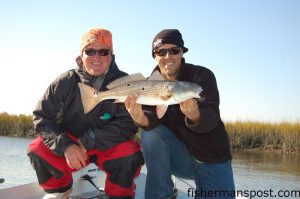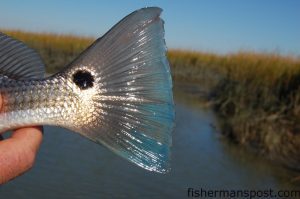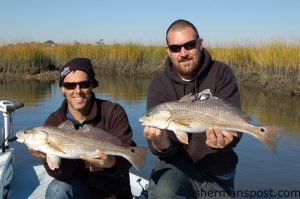The Red Score Explored

Capt. Robert Schoonmaker, of Carolina Explorer Charters, and Gary Hurley, of Fisherman's Post, with a slot red drum that fell for a custom-dyed Gulp bait in a creek off the Lower Cape Fear River.
“It did get 10 degrees warmer out here,” Capt. Robert Schoonmaker said, making good on an earlier prediction, as he hopped out of his truck at the newly redone boat basin at Fort Fisher.
The winter’s morning chill had moderated a bit since we’d met Robert, who operates Carolina Explorer Charters, at Carolina Beach’s Gulf Stream Restaurant for breakfast prior to searching for some chilly water red drum in the backwaters of the Lower Cape Fear River.
“The tide’ll be better in a little while, and it should warm up a bit,” Robert explained as we accepted steaming coffee cups. Many of Robert’s trips begin at one of Gulf Stream’s tables, and a pre-fishing meal and a few hot cups of coffee while the mercury climbed sounded to me like an ideal way to begin a day on the water.
Stomachs filled with country ham, bacon, and biscuits as we stood on the dock, Gary and I eagerly lowered our gear into the “Redfish Explorer,” the custom 20’x8’ skiff Robert built in his backyard specifically for targeting reds in the shallows off the lower river.
“There’s been a good group of fish on a flat in one of the bays down here,” Robert said as he throttled up the 60 hp Yamaha four-stroke powering the battleship-gray fishing machine. “We’ll head down there and go looking for them.”
A Carolina Beach native, Robert had happily answered a fusillade of questions from Gary regarding the whereabouts of many of the fishermen who’d been around the docks back when Fisherman’s Post began and the Publisher had more luxury time to spend away from the office. Reminiscing about the old guard gave way to talk of fish as Robert slowed to an idle after a short run through the marshy backwaters between Fort Fisher and Bald Head Island.
Taking stock of the conditions, Robert didn’t seem overly optimistic.
“I’m sure those fish are here,” he explained, scanning an open bay, “but with this hard north wind, it’s too choppy to see them easily.”
A few moments later, the captain scrapped the bay plan.
“We should be able to find some in the creeks,” he explained, pointing the boat’s bow south again, “and we’ll be out of the wind.”
Moments later, Robert cut the power to the outboard and, scrambling up the skiff’s wide, walkaround gunwale, dropped the trolling motor into the tannin-stained water beneath the bow. After getting the boat on a course parallel to a long sandbar heading up the creek, he handed us each a medium-action spinning outfit rigged with a jighead and a 3” Gulp shrimp, mine in New Penny and Gary’s a custom color.
“Spike-It just came out with a dye for Gulps,” Robert said, gesturing to Gary’s bright pink/orange bait. “That color’s been the secret weapon lately.”
“Do not get that stuff on your hands, though,” he added with a grin, conjuring thoughts of a permanently pink paw that made further discussion of the point unnecessary.
Making a few casts as we slid past the bar and further into the creek, Gary turned to Robert at the trolling motor.
“What kind of action are we looking for?” he queried. “Steady? Bump it a little?”
“Yeah, bump it,” Robert replied, negotiating a muddy curve. “You just want it to hit bottom every now and again. We catch plenty of trout and flounder fishing like this, too.”
Casting an ear to the conversation while my jig flew towards grass points and shell beds lining the creek, I took the captain’s advice as well.
A few casts later, on a toss paralleling a straight stretch of bank, I felt a light thump and raised my rod tip to some slight resistance. The fish coming at me and staying down, I knew I hadn’t found the day’s first drum.
“Well, I do believe I’ve got one of your flounders,” I said to Robert, and moments later, he slid a net under a small flatfish.
“I definitely wouldn’t mind keeping him if he’s big enough,” I added as the fish flopped. The measuring tape found the fish ½” shy of dinner, but I was still happy to have my personal skunk off my shoulders a half-dozen casts into the day.
Rounding yet another of the winding bends in the creek’s spartina grass banks, the waterway widened a bit where a shell bed dropped off into a deeper pocket.
“You guys throw back to that shell bank and just bump down into that hole,” Robert said, positioning the boat so we’d each have a clear casting lane. “Any kind of structure, like the shell bars and points, can hold fish.”
Our first casts went unrewarded, but probing a bit further into the pocket with my second, my Gulp bait met an abrupt stop.
“There you go, Max!” Robert exclaimed as my rod took a much deeper bend than it had for the flounder.

Capt. Robert Schoonmaker shows off the iridescent blue tail of a juvenile red that took an interest in a Gulp bait near an oyster bar in less than a foot of water.
I glanced at Gary, intending to toss out a gloating word about the first hookup, but noticed he, too, had set the hook and was battling a fish of his own.
Moments later, my fish was able to shake the hook, but Gary was still fighting his, gaining a yard or two of line before the fish took it back, nowhere to run in the tight channels, but still far too energetic to come to the landing net. If the robust surges the fish was making hadn’t already clued us in, the distinctly spotted tail boiling the surface in the tight quarters let us know we’d found some reds.
“Better put down the ‘power pole’,” Robert said with a grin, loosening the collar on his trolling motor to jam the lower unit into the muddy bottom and hold the boat in position just off the spot where we’d hooked up.
I arced another cast into the strike zone while Gary followed his around the bow and down the gunwale, hoping to make up for my lost fish with another hookup, but was unable to connect.
Meanwhile, the down and dirty battle in a pocket the size of a cargo van was swinging in Gary’s direction, as the fish’s boils were coming closer and closer to the boat. Robert had the landing net ready as Gary worked the fish the final few feet into range, and soon the day’s first drum lay on deck, a 22-incher sporting three spots on a pair of copper flanks shinier than the New Penny Gulp bait I was casting. Sadly, the gloater had become the gloated, and I endured a little ribbing after Gary’s fish was in hand.
After snapping a few photos of the red and easing it back into the water, Gary and I resumed casting, hoping to score some more bites in the deeper water.
“Do they typically hold in these deeper holes in the winter?” I quizzed Robert, hoping to glean a little knowledge that might give me the edge as we neared more productive water.
“They can be anywhere from 4 inches of water to 4 feet,” Robert replied. “They just kind of meander around.”
A few more casts into the pocket went unrewarded, and Robert quickly lifted the trolling motor from the mud and resumed piloting us through more of the creek’s twists.
Another deeper hole on the outside of a creek bend produced another bent rod for Gary, and another brief but intense battle in a spot where the skiff’s length would have easily touched each bank.
With his second fish on the books, the ribbing became slightly more intense.
“I think it’s the action,” Gary said glibly.
Firing casts to the same spots, and using the same simple retrieve, I was inclined to credit the publisher’s luck.
The creek soon became little more than a rivulet, too small to allow even the shallow draft “Redfish Explorer” passage, but Robert pulled all the way to the end, revealing a deeper pocket on the other side of a large, exposed shell mound.
“They’ll get in there, so give it a few casts,” he said, again grounding the trolling motor to keep us from drifting off. Gary and I obliged, sending baits across 5’ of dry shell before they hit the water. Though we didn’t coax any bites, a pair of slightly smaller reds did ‘meander’ after our baits, interested, but likely a bit too cold to commit fully.
“Let’s try one creek over,” Robert said after watching us come up empty-handed after a few minutes. We made our way back to the creek’s mouth, and Robert fired up the big motor for a short trip towards a creek off the west side of the bay.
A few tosses into the new creek, I got another solid strike, and set the hook into a red that quickly betrayed itself with another signature tail boil. Again, Gary was hooked up almost immediately after I’d gotten the bite, dashing my hopes that I’d be able to work on evening the red score.
Both hooks held up, and with a little more room to work within a somewhat wider creek basin, the fish each made some longer runs than the earlier reds had been able to. Time and drag pressure took their toll, however, and within seconds of each other, Robert was able to net the fish for a quick tandem photo session.
Though I couldn’t claim to be on top of the fish count, finally putting a red in the boat bolstered my confidence, and I was soon back in the game, chastising Gary for an errant cast into the grass and pointing to the fences on nearly every cast.
“Here comes number two, baby!” escaped my lips a number of times before it actually came true, but eventually I fulfilled my self-prophecy and added another fish to the tally.
Gary, however, had connected with several more in the interim, and the “right action” chatter began anew.
Even the friendliest (and Robert is certainly that) guy can only watch a show like this for so long, and after Gary released another healthy, mid-slot red, Robert could contain himself no longer.

Hurley and Fisherman's Post Editor Max Gaspeny with a pair of mid-slot reds that fell for Gulp shrimp on light jigheads near an oyster-covered bend in a creek near Bald Head Island.
“Max, when Gary catches another nice one, you should get a picture with it,” the Carolina Explorer chimed in, grinning.
I had little recourse and took my lumps with a matching grin. As we fished out the remainder of the falling tide, Robert taking us on a labyrinthine tour of several other creeks, we connected with a few more reds, with Gary closing the books on the day by landing a beautiful, final, undersized red with the bluest tail I’ve ever seen on a drum.
Perhaps there’s something to all that action talk.
An account of our day would be lacking without a few words about Robert’s boat. The unique machine is deservedly a source of pride to the captain who built it, and tailored to the lower river’s fishery beautifully.
With a fully flat bottom, the boat only draws 3” of water, meaning Robert can get into and out of spots that would laugh at bay boats and most flats boats on the market today, spots where red drum hole up all winter long, meandering about with little-to-no fishing pressure.
A tall poling tower above his motor gives the captain a perch to look for signs of fish and pole the boat through the skinny to give anglers shots at tailing fish that would be inaccessible to most other craft, and a bench midway up the tower allows him to run the tiller-steer boat seated, but with a similar vantage point to someone standing up behind a center console.
Since the boat lacks a console, it is incredibly roomy and seems much bigger than 20’, and there are zero obstructions to impede an angler following a fish around the vessel. His anglers also enjoy the luxury of relaxing in comfortable folding chairs that disappear into the massive forward and rear storage areas when it’s time to fish.
In short, the “Redfish Explorer” may be the ultimate boat for pursuing inshore species in protected shallow environs, and, at a number of times during our trip, it occurred to me that both boat and captain seemed as at home in the bays and creeks here as the birds, crabs, and fish they share the lower Cape Fear marshes with.
In addition to the “Redfish Explorer,” Robert runs inshore and nearshore trips on a 24’ Mako bay boat, pursuing the same inshore targets along with kings and spanish mackerel, gray trout, black sea bass, and more. If it swims within a few miles of Carolina Beach, Capt. Robert Schoonmaker has spent much of his life chasing it, so anyone looking for a productive and informative day on these waters owes themselves a Carolina Explorer trip.
Anglers can get more information by calling Robert at (910) 264-1807 or checking out his website at www.carolinaexplorer.com.
